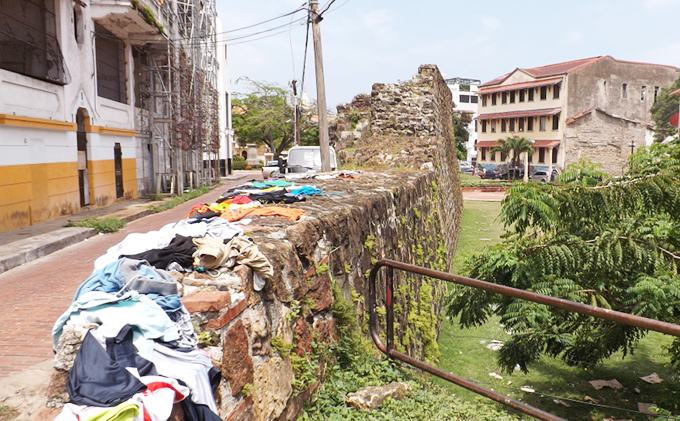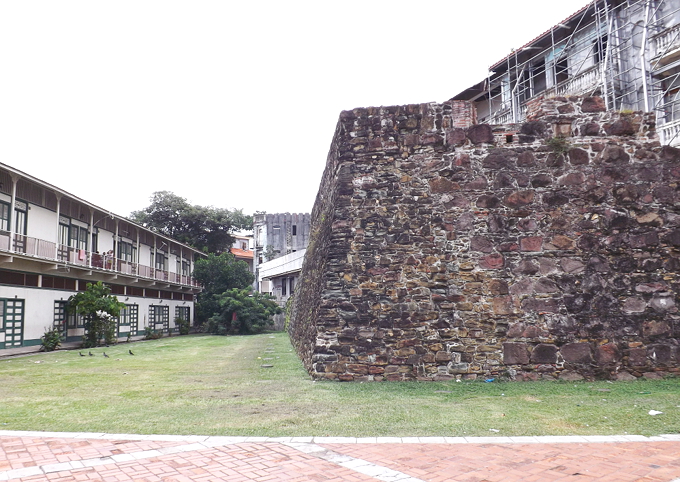
The Wall
photos and historical note by Eric Jackson
Morgan’s 1671 raid on Panama la Vieja was one of the last major military campaigns in the Wars of the Reformation — if you don’t count things that have gone on in Ireland, especially Northern Ireland, down into our times — but troubles with the British crown, and with various species of pirates and privateers, did not end. The colonial city established by Pedrarias the Cruel did end in a fashion, as between the Spanish scorched earth policy and the British looting and destruction there wasn’t much that was left intact. Within a few years a new city center was begun on a rocky peninsula a few miles to the west, in what is now the corregimiento of San Felipe. That site was chosen for its ability to be militarily defended. The best preserved defenses are around Plaza Francia, with a tall sea wall, the old dungeons and military and government offices and, as you can see on the side facing Amador, the wall where Liberal guerrilla General Victoriano Lorenzo and others faced firing squads. (There is a plaque on the spot of that infamous act of the Conservative regime that was in control of Panama City in May of 1903.)
But facing landward there was also a tall and thick defensive wall, with gun positions every 200 or so feet, which had a surrounding moat and highly restricted access by three gates with drawbridges. After Morgan’s raid the arguments with the Brits were not so much over the relative merits of Catholicism and its Protestant offshoots but about trade policies, European dynastic successions and esoterica like Captain Jenkins’s ear. But while the Atlantic Side and adjacent Caribbean waters and the roads leading to and from Panama City remained vulnerable to British predation, nobody ever tried to force their way past the wall around the Casco Viejo.
In the middle of the 18th century those hostilities ended with a series of whimpers, but the wall persisted for another century, through Panama’s independence from Spain and into the era of Colombia’s endless civil wars being played out in Panama. With those political changes there was a continuity and a series of alterations in the wall’s purpose.
If British corsairs were the original fear, there was also the function of defending the Spanish elite of church and state from slave revolts. As it turned out this was not as big a problem as feared because the main form of resistance for African slaves was to escape to the jungle and join Cimarron communities, black villages in which aspects of West African culture, religion and governance persisted. There was a Spanish Inquisition court in Cartagena to deal with the African religions but for an increasingly destitute Spanish Empire going after these communities was mostly not worth the bother. The Spaniards still had slavery, with all of its implications, until early in the 19th century. This wall and the rest of the original buildings of the Casco Viejo, like Panama La Vieja and the fortifications of such Atlantic Side sites as Portobelo, Fort San Lorenzo and Nombre de Dios, were built by black slaves.
Surely the names of the architects who drew up the plans for the Casco Viejo’s wall, gates, moat and drawbridges are still written down somewhere — back in Madrid the Spanish government was concerned about the project’s cost and would have wanted to know such details — but along with the wall’s existence and purposes, these data have dropped out of popular memory here. (Research by Dr. Roberto Bruno has revealed the role of Italian military architects in many of Panama’s colonial era fortifications.) The thread of the nation’s memory of the wall picks up in 1856, after slavery was abolished but when racial stratification persisted, and when the rising new threat from the English-speaking world was directed out of Washington rather than London.
Back then there were these would-be American conquerors from the southern slave states, looking to imitate what had happened in Texas by conquering parts of Latin America and turning them into new slave states to affect the balance of power in the US Senate. The most infamous of these men, called filibusters, was a “gray-eyed man of destiny,” William Walker. To have a Casco Viejo in which the only black people welcome at night were domestic servants must have looked like an attractive prospective capital of a new slave state to men like this. To the cruder Americans crossing the isthmus at a time when popular and ultimately legal US opinion was that black people have no rights that whites are bound to respect, a Panama without slavery was a place for constant insults and fights. It came to a head in April of 1856 in the slums outside the Casco Viejo walls, when a white American named Jack Oliver took it upon himself to swipe a piece of watermelon from a black vendor, José Manuel Luna. The latter asserted his right to be paid and the former introduced a pistol into the argument. When the smoke cleared dozens were dead and US forces invaded Panama not long afterward.
So by the middle of the 19th century the wall was not only a symbol that attracted a wrong sort of notice that itself posed a military threat and no longer was needed to resist slave revolts in a place where that social relationship had been abolished. Inside the Casco Viejo much of the colonial construction was in ruins due to the ravages of an earthquake and several major fires. The place needed to be rebuilt and the wall didn’t fit into the plans. Thus, beginning in the middle of the 19th century, the old landward facing fortifications began to be dismantled. This remnant, not far from the Casco Viejo’s Plaza Herrera, is one of the last visible reminders.

~ ~ ~
These announcements are interactive. Click on them for more information.










